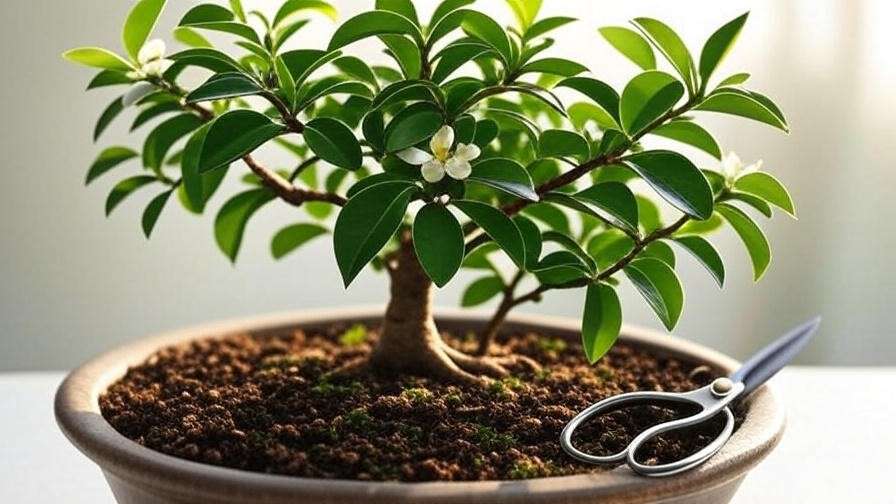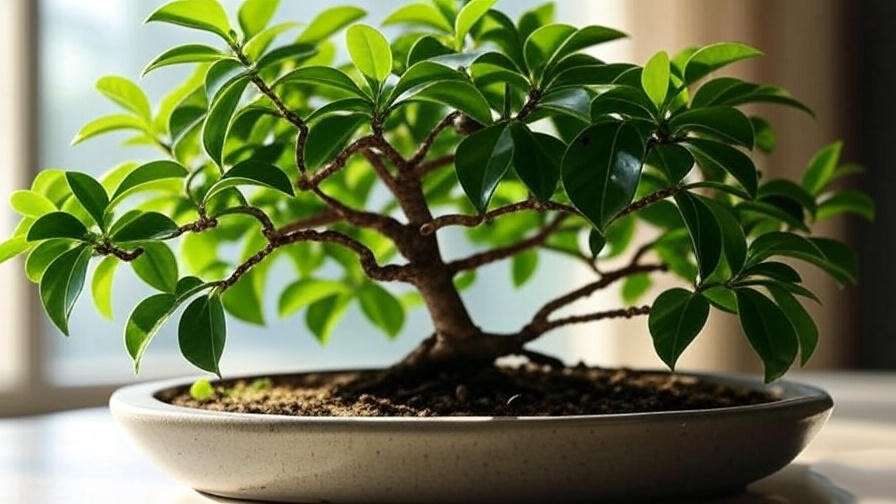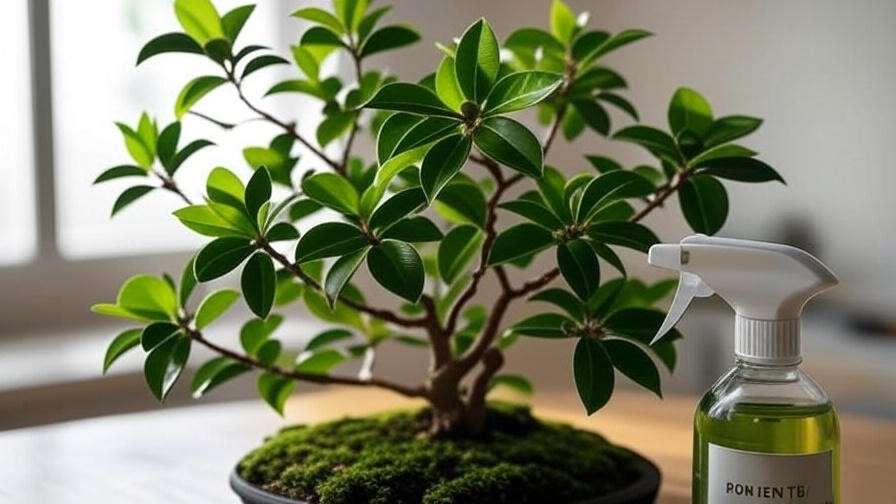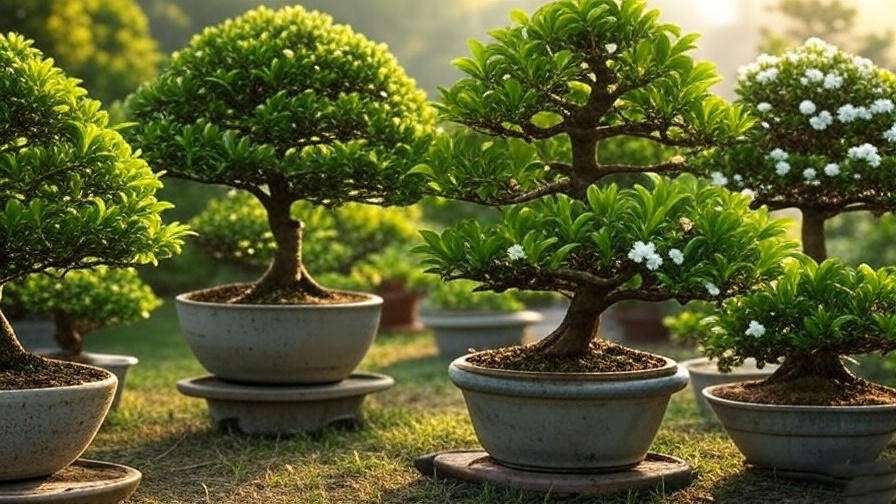Imagine transforming a corner of your home into a serene oasis with a miniature tree that blooms with delicate white flowers and lush green leaves. The Fukien Tea Bonsai Tree (Carmona retusa) is that perfect blend of elegance and tranquility, making it a favorite among bonsai enthusiasts. Whether you’re a beginner or a seasoned plant lover, this guide will equip you with everything you need to grow a thriving Fukien Tea Bonsai. From light and watering to pruning and pest control, we’ve distilled decades of bonsai expertise into actionable steps to ensure your bonsai flourishes. 🌿 Let’s dive into the art of Fukien Tea Bonsai care and address common challenges to help you cultivate a masterpiece!
1. Understanding the Fukien Tea Bonsai Tree 🌳
1.1 What Is a Fukien Tea Bonsai?
The Fukien Tea Bonsai, scientifically known as Carmona retusa, hails from Southeast Asia, particularly southern China, Taiwan, and parts of Indonesia. Named after China’s Fujian province, this evergreen shrub is prized for its small, glossy, dark-green leaves, delicate white flowers, and tiny red or orange fruits that add charm year-round. Its compact size—typically 6 to 12 inches tall as a bonsai—makes it ideal for small spaces, while its forgiving nature suits beginners.
Unlike other bonsai species, the Fukien Tea adapts well to indoor environments, thriving in controlled conditions. Its versatility and aesthetic appeal make it a go-to choice for those new to the art of bonsai cultivation. With proper care, this tree can live for decades, becoming a living testament to your horticultural dedication.
1.2 Benefits of Growing a Fukien Tea Bonsai
Cultivating a Fukien Tea Bonsai offers more than just visual appeal. This miniature tree enhances home decor with its intricate branches and vibrant foliage, creating a calming focal point in any room. Beyond aesthetics, bonsai care promotes mindfulness, patience, and a deeper connection to nature. The process of tending to your bonsai—pruning, watering, and shaping—can be a meditative practice, reducing stress and fostering creativity.
Additionally, the Fukien Tea Bonsai’s ability to flower and fruit adds a dynamic element to its charm. Imagine the joy of seeing tiny white blossoms or colorful fruits on your tree, a reward for your attentive care. For beginners, this bonsai’s resilience makes it an excellent starting point to master bonsai techniques without overwhelming complexity.
2. Essential Care Requirements for Fukien Tea Bonsai 🌞
2.1 Light and Temperature Needs
Light is the lifeblood of your Fukien Tea Bonsai. This tree thrives in bright, indirect sunlight for 4–6 hours daily. A south- or east-facing windowsill is ideal, but avoid direct midday sun, which can scorch leaves. If natural light is limited, especially during winter, supplement with a full-spectrum grow light to mimic sunlight. Aim for 12–16 hours of artificial light daily to keep your bonsai vibrant.
Temperature is equally critical. Fukien Tea Bonsais prefer a range of 60–75°F (15–24°C). Protect your tree from cold drafts near windows or air conditioning vents, as temperatures below 50°F (10°C) can cause stress. Conversely, avoid placing it near heaters, which can dry out the foliage. Expert Tip: If you notice slow growth or leaf drop, check for temperature fluctuations and adjust the tree’s location accordingly.
2.2 Watering Guidelines 💧
Watering a Fukien Tea Bonsai is a balancing act. The goal is to keep the soil consistently moist but never waterlogged. Depending on your climate and indoor humidity, water every 2–3 days. To check if watering is needed, insert your finger about half an inch into the soil; if it feels dry, it’s time to water. Alternatively, a moisture meter can provide precise readings.
Use room-temperature water and pour slowly until it drains from the pot’s bottom. Ensure your pot has drainage holes to prevent root rot, a common issue caused by overwatering. Signs of overwatering include yellowing leaves or a musty smell from the soil. If this happens, reduce watering frequency and improve air circulation around the tree.
2.3 Soil and Potting 🪴
The right soil mix is crucial for a healthy Fukien Tea Bonsai. Opt for a well-draining bonsai soil blend, such as a mix of akadama (60%), pumice (20%), and lava rock (20%). This combination ensures proper aeration and drainage while retaining enough moisture for the roots. Avoid heavy garden soil, which can compact and suffocate roots.
Choose a shallow, wide bonsai pot with drainage holes to promote healthy root growth. Repot your bonsai every 2–3 years, typically in spring, to refresh the soil and prevent root binding. During repotting, trim about one-third of the root mass to encourage new growth, being careful not to disturb the tree’s core root structure. Expert Insight: After repotting, water thoroughly and keep the tree in a shaded area for 1–2 weeks to reduce stress.
3. Pruning and Shaping Your Fukien Tea Bonsai ✂️
3.1 Pruning Techniques
Pruning is the heart of bonsai artistry, maintaining your Fukien Tea’s shape and encouraging dense, compact foliage. Regular pruning involves trimming back new growth to 2–3 leaves once a branch has 6–8 leaves. This promotes a fuller canopy and prevents leggy growth. Use sharp, precision bonsai shears for clean cuts, and disinfect tools with rubbing alcohol to prevent disease spread.
For structural pruning, remove dead, damaged, or crossing branches in early spring before the growing season. Always cut at a 45-degree angle just above a leaf node to encourage new buds. Avoid heavy pruning in winter, as the tree’s growth slows down. Beginner Tip: Start with light pruning to gain confidence, and observe how your tree responds before making bolder cuts.

3.2 Wiring for Shape
Wiring allows you to sculpt your Fukien Tea Bonsai into stunning shapes, such as informal upright or cascade styles. Use anodized aluminum bonsai wire, wrapping it gently around branches at a 45-degree angle. Start wiring in spring or early summer when branches are flexible. Check wires every 4–6 weeks to ensure they don’t cut into the bark as the tree grows.
To avoid damage, remove wires after 2–3 months or once the branch holds its shape. If you’re new to wiring, practice on less critical branches to perfect your technique. Caution: Over-wiring can stress the tree, so monitor for signs of strain, such as wilting leaves.

4. Fertilizing and Nutrition 🍽️
Fertilizing your Fukien Tea Bonsai ensures it has the nutrients needed for vibrant growth and flowering. Use a balanced liquid bonsai fertilizer (10-10-10 NPK) every two weeks during the growing season (spring and summer). In fall and winter, reduce to monthly applications to match the tree’s slower metabolism. Dilute the fertilizer to half-strength to prevent nutrient burn, which can cause leaf browning.
Organic alternatives like fish emulsion or seaweed extract are excellent for natural care. Apply fertilizer to moist soil to enhance absorption. Expert Insight: If your bonsai is flowering, switch to a phosphorus-rich fertilizer (e.g., 5-10-5) to boost bloom production. Always follow the product’s instructions to avoid over-fertilizing.
5. Common Problems and Solutions 🩺
5.1 Pests and Diseases
Like any plant, the Fukien Tea Bonsai Tree can face pest and disease challenges, but with vigilance, these issues are manageable. Common pests include spider mites, aphids, and scale insects. Spider mites, tiny arachnids, leave fine webbing and cause stippled leaves. Aphids cluster on new growth, sucking sap and weakening the tree. Scale insects appear as small, waxy bumps on stems and leaves.
To combat pests, start with organic solutions. Apply neem oil or insecticidal soap weekly until the infestation clears. Mix 1 teaspoon of neem oil with 1 quart of water and a drop of dish soap for a safe spray. Ensure good air circulation around your bonsai to deter pests. For severe infestations, consult a local nursery for targeted treatments. Expert Tip: Inspect your bonsai weekly under bright light to catch pests early.
Fungal diseases like root rot and leaf spot can occur if the tree is overwatered or lacks airflow. Root rot, caused by waterlogged soil, leads to wilting and a foul-smelling root system. Leaf spot appears as dark, wet patches on leaves. Prevent these by using well-draining soil and avoiding overhead watering. If root rot is suspected, remove affected roots during repotting and treat with a fungicide. For leaf spot, remove infected leaves and improve ventilation.

5.2 Leaf Drop and Yellowing
Leaf drop and yellowing are common concerns for Fukien Tea Bonsai owners, often signaling environmental stress. Overwatering is a frequent culprit, causing roots to suffocate and leaves to fall. Check soil moisture before watering and ensure proper drainage. Insufficient light can also trigger leaf drop, as the tree struggles to photosynthesize. Move your bonsai to a brighter spot or use a grow light.
Temperature fluctuations, especially drafts or sudden changes, can cause yellowing. Keep your bonsai in a stable environment, away from vents or open windows. Beginner Tip: If leaves drop suddenly, assess recent changes in care—did you move the tree or alter watering habits? Adjust one variable at a time to pinpoint the issue.
5.3 Slow Growth
Slow growth can frustrate beginners, but it’s often a sign of correctable issues. Nutrient deficiency is a common cause; ensure you’re fertilizing regularly with a balanced formula. Inadequate light can also stunt growth, so confirm your bonsai receives 4–6 hours of bright, indirect light daily. A pot-bound tree, with roots circling the container, may also grow slowly. Check during repotting and trim roots if needed.
If growth remains sluggish, evaluate humidity levels. Fukien Tea Bonsais thrive in 50–70% humidity, which can be low in indoor settings. Use a humidity tray filled with pebbles and water, placed beneath the pot, to boost moisture. Expert Insight: Mist the foliage daily in dry climates, but avoid over-misting to prevent fungal issues.
6. Seasonal Care Tips for Fukien Tea Bonsai ❄️☀️
Caring for your Fukien Tea Bonsai varies by season, as its needs shift with environmental changes. Here’s how to adapt your care routine:
- Spring: As growth resumes, increase watering and fertilization. Prune lightly to shape the tree and remove winter-damaged branches. This is the ideal time for repotting, as the tree recovers quickly. Ensure bright light to support new growth.
- Summer: Protect your bonsai from intense heat and direct sunlight, which can scorch leaves. Water more frequently, as warmer temperatures dry out soil faster. Mist leaves to maintain humidity, especially in air-conditioned spaces.
- Fall: Gradually reduce watering and fertilization as growth slows. If moving your bonsai indoors, acclimate it over a week to avoid shock. Check for pests, as fall is a common time for infestations.
- Winter: Indoors, maintain stable temperatures (60–75°F) and use a humidity tray to combat dry air from heating systems. Rotate the tree every 1–2 weeks for even light exposure. Limit pruning to minor maintenance.
Expert Tip: Keep a care journal to track seasonal changes and your bonsai’s response. This helps identify patterns and refine your routine over time.

7. Indoor vs. Outdoor Growing 🌍
The Fukien Tea Bonsai is versatile, thriving indoors or outdoors depending on your climate. Indoor growing is ideal for most regions, offering control over light, temperature, and humidity. Place your bonsai near a bright window or under a grow light, and use a humidity tray to mimic its tropical origins. Indoor growing protects the tree from frost and extreme weather, making it suitable for beginners.
Outdoor growing works in USDA hardiness zones 9–11, where temperatures rarely dip below 50°F. Place the bonsai in a semi-shaded spot, shielded from harsh afternoon sun and heavy rain. Outdoor trees benefit from natural light and air circulation but require protection from frost. If temperatures drop, bring the tree indoors or use a cold frame.
Transitioning between indoor and outdoor settings requires care. Move the tree gradually over 7–10 days, increasing outdoor exposure by an hour daily to prevent shock. Pros and Cons: Indoor growing offers stability but demands supplemental light and humidity; outdoor growing provides natural conditions but risks weather-related stress.
8. Advanced Tips for a Thriving Fukien Tea Bonsai 🌟
Once you’ve mastered basic care, elevate your Fukien Tea Bonsai with advanced techniques:
- Training for Unique Styles: Experiment with bonsai styles like informal upright (moyogi), cascade (kengai), or forest (yose-ue). Each style requires specific pruning and wiring techniques. For example, cascade styles emphasize downward growth, achieved by wiring branches to curve gracefully.
- Encouraging Flowering: To promote blooms, ensure ample light, high humidity, and a phosphorus-rich fertilizer (e.g., 5-10-5 NPK). Flowers typically appear in spring or summer, adding charm to your bonsai.
- Long-Term Care: With proper care, a Fukien Tea Bonsai can live for decades. Regularly refresh soil, monitor root health, and adjust shaping as the tree matures. Document its growth with photos to track progress.
- Community Support: Join a local bonsai club or online forums like Bonsai Empire or Reddit’s r/Bonsai for inspiration and advice. Sharing experiences with other enthusiasts can spark new ideas and solutions.
Expert Insight: Renowned bonsai master John Naka once said, “Bonsai is not about control, but about harmony with nature.” Approach your Fukien Tea Bonsai with patience and respect for its natural rhythms.

9. FAQs About Fukien Tea Bonsai Care ❓
- How often should I water my Fukien Tea Bonsai?
Water every 2–3 days, ensuring the soil stays moist but not soggy. Use the finger test or a moisture meter to confirm. - Why is my bonsai dropping leaves?
Leaf drop often results from overwatering, low light, or temperature changes. Adjust care and monitor for improvement. - Can I grow a Fukien Tea Bonsai in low light?
Low light is not ideal; supplement with a grow light to ensure 4–6 hours of bright, indirect light daily. - How do I know when to repot my bonsai?
Repot every 2–3 years or when roots circle the pot. Spring is the best time for repotting. - What’s the best fertilizer for my Fukien Tea Bonsai?
Use a balanced liquid fertilizer (10-10-10) diluted to half-strength every 2 weeks during the growing season.
10. Conclusion
Growing a thriving Fukien Tea Bonsai Tree is a rewarding journey that blends horticultural skill with artistic expression. By providing proper light, consistent watering, thoughtful pruning, and seasonal care, you can cultivate a miniature masterpiece that brings beauty and tranquility to your space. Whether you’re shaping its delicate branches or coaxing out vibrant blooms, each step deepens your connection to this ancient art form. Start today, embrace the process, and share your Fukien Tea Bonsai progress with #BonsaiBeginner! 📸 For more tips, explore our related articles on bonsai tools and pest control, and let your bonsai journey flourish! 🌿













